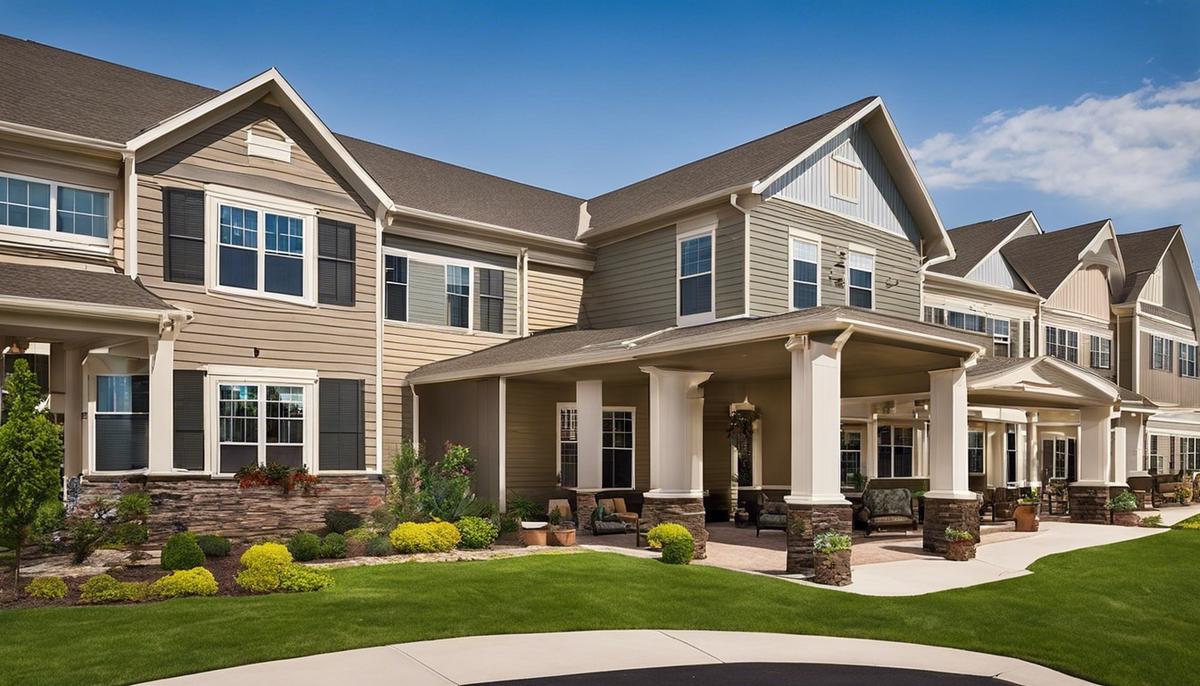Choosing where to live in retirement is a big decision that affects many parts of your life. It’s not just about picking a place; it’s about finding a community that fits your lifestyle and needs. This article will explore the important factors to consider, from the impact of location on your daily life to the types of housing and care available, and finally, how to plan financially for a comfortable future in a retirement community. It’s about making informed choices to ensure a happy, fulfilling retirement.
Evaluating the Location and Its Impact
Choosing the right location for a retirement community is more than just picking a place to live; it significantly influences your day-to-day experiences. When searching for the perfect retirement community, considering location is key to ensuring a lifestyle that matches your preferences and needs.
First, let’s talk about the impact of climate and geography. Some people dream of warm, sunny days year-round, making locations like Florida or Southern California ideal. The pleasant weather allows for outdoor activities such as gardening, walking, and golfing, keeping seniors active and engaged. On the other hand, those who appreciate the change of seasons might prefer retirement communities in the Midwest or New England, where cooler temperatures and seasonal changes offer a different kind of beauty and recreational options like fall foliage tours and winter snow activities.
Proximity to urban areas is another consideration. Retirement communities near cities offer easy access to cultural attractions, healthcare facilities, dining, and shopping. Being close to museums, theaters, and educational institutions provides endless opportunities for lifelong learning and entertainment. However, some may prefer the tranquility and slower pace of rural settings, where nature is at your doorstep, and the environment can be more peaceful and less crowded.
The closeness to family and friends cannot be overlooked. Living near loved ones makes it easier to maintain strong connections, enjoy regular visits, and receive support when needed. For many, this proximity brings peace of mind and a sense of security. However, moving to a new location can also be an adventure, offering the chance to make new friends within the community who share similar interests and life stages.
Lastly, the cost of living varies significantly by location and can affect your lifestyle choices in retirement. Areas with a higher cost of living may offer more amenities and services, but they can also strain your budget, affecting how often you can dine out, travel, or pursue hobbies. On the other hand, areas with a more affordable cost of living might offer fewer amenities but allow for a more comfortable lifestyle on a fixed income.
In conclusion, the location of a retirement community shapes your daily life through the climate and geography, access to urban amenities and healthcare, proximity to loved ones, and the cost of living. These factors influence your ability to enjoy hobbies, connect with others, and live comfortably. Choosing the right location is a personal decision that depends on your priorities, lifestyle preferences, and financial situation.

Understanding Available Amenities and Services
In senior living communities, the amenities and services offered can significantly enhance the quality of life for residents. These facilities aim to create a supportive, vibrant environment where seniors can thrive. From physical fitness facilities to cultural enrichment programs, the range of amenities and services is designed to meet the diverse needs and interests of senior residents.
A key aspect of these communities is the emphasis on physical wellness. Many offer fitness centers, swimming pools, and group exercise classes tailored to senior citizens. These resources make it easier for residents to maintain their physical health and manage or prevent chronic conditions. Additionally, outdoor walking trails and gardens encourage an active lifestyle while providing serene spaces for relaxation and enjoyment of nature.
Nutritional needs are also a focal point in senior living communities. Dining services typically provide nutritious, chef-prepared meals that cater to a variety of dietary restrictions and preferences. This not only ensures residents receive balanced meals but also removes the stress and difficulty of meal planning and preparation. The communal dining experience fosters social interaction, helping residents build relationships and combat feelings of isolation.
Social and recreational activities are another cornerstone of these communities. From art classes and music performances to movie nights and educational lectures, the array of events caters to a wide range of interests. These activities not only stimulate the mind but also provide valuable opportunities for socialization, enhancing residents’ emotional well-being.
The services offered in senior living communities further alleviate the burdens of daily living. Housekeeping, laundry, and transportation services are commonly available, offering convenience and peace of mind to residents and their families. This level of support allows seniors to live independently while ensuring help is available when needed.
Technology services in senior living communities also play a critical role in enhancing resident life. Many facilities provide Wi-Fi, digital communication tools, and tech support to help residents stay connected with family and friends. This accessibility to technology helps bridge the gap between generations and supports residents in navigating the digital world.
For those requiring assistance with daily living activities, personalized care plans ensure that individual needs are met with dignity and respect. The care team’s involvement ranges from medication management to assistance with personal care, tailored to the individual’s requirements. This personalized approach ensures that residents receive the support they need while maintaining as much independence as possible.
In conclusion, the amenities and services offered by senior living communities are integral to providing a quality of life that supports residents’ physical, nutritional, social, and emotional well-being. By focusing on creating a supportive and vibrant environment, these communities play a vital role in ensuring that senior residents can lead fulfilling lives with the level of care and support they need.

Types of Housing and Levels of Care Provided
In the journey through retirement, the choice of housing and care levels is paramount in shaping the lifestyle and well-being of retirees. It’s not just about a place to live, but a space that supports a fulfilling, comfortable, and secure life. Recognizing the diversity among retirees, various housing options and care levels have been established to cater to their broad spectrum of needs, preferences, and health statuses.
Understanding Housing Options
- Independent Living: This option is ideal for those who are active and can live independently but seek the benefits of community living. Independent living facilities often provide convenient access to fitness centers, social clubs, and cultural activities, fostering a vibrant community atmosphere.
- Assisted Living: Assisted living bridges the gap for seniors who require help with everyday tasks but do not need the intensive medical and nursing care provided in nursing homes. These facilities offer a balanced approach to support day-to-day independence, with services like medication management, personal care assistance, and mobility support.
- Nursing Homes: For retirees who need a higher level of medical care and assistance, nursing homes offer 24-hour supervised care with a range of health and personal care services. This option is suited for individuals with serious health conditions requiring constant monitoring.
- Continuing Care Retirement Communities (CCRCs): CCRCs offer a comprehensive care platform, allowing retirees to transition between independent living, assisted living, and nursing home care as their needs change, without the stress of relocating.
- Memory Care: Specifically designed for those with Alzheimer’s disease, dementia, and other cognitive impairments, memory care units offer specialized programs and environments to enhance safety, comfort, and well-being.
Catering to Care Levels
The diversity in retirees’ health and independence levels necessitates a personalized approach to care. By evaluating individual needs, housing options can offer tailored services that range from minimal assistance in an independent living setting to intensive medical care in nursing homes. Furthermore, many facilities incorporate wellness programs, emergency response systems, and accessibility features to address the evolving needs of their residents.
Evolving with Technology
Advancements in technology have significantly impacted retiree housing and care, introducing tools like medical alert systems, telehealth services, and cognitive health programs. These technologies not only enhance safety and health monitoring but also empower seniors to maintain a degree of independence.
Financial Planning and Support
Understanding and planning for the financial aspect of retiree housing and care is critical. Options vary widely in cost, affected by location, services, and amenities offered. Many retirees utilize savings, long-term care insurance, veterans’ benefits, or Medicaid to fund their housing and care needs. It’s important to explore all financial avenues to make an informed decision that aligns with both care needs and budget.
In conclusion, the landscape of retiree housing and care is diverse and multifaceted, designed to cater to the unique needs and preferences of seniors. From the independence of senior apartments to the comprehensive care of nursing homes and everything in between, understanding the options available is the first step toward making an informed decision that ensures a safe, comfortable, and fulfilling retirement.

Financial Considerations and Planning for Retirement Living
Planning for life in a retirement community involves more than just choosing the right location or type of care; it requires thoughtful financial strategies to ensure a comfortable and secure future. Here’s how to navigate these waters effectively.
Budgeting for Future NeedsStart by evaluating your current financial situation. List out your assets and income, including savings, investments, retirement accounts, and any other income sources like pensions or social security benefits. Then, forecast your potential expenses in a retirement community, including housing, utilities, care services, activities, and additional health care needs. Balancing these two will give you a clearer picture of what you can afford and where adjustments might be necessary.
Understanding CostsRetirement communities come with various costs, often dependent on the level of care and services provided. Understand the fee structures – some may have a monthly cost that covers many aspects of living, while others might charge additional fees for extra services. Ask for detailed breakdowns and consider how these align with your budget.
Exploring Financial Assistance OptionsFor many, personal savings and income may not cover all the costs associated with retirement living. Investigate other financial resources that you might be eligible for. Long-term care insurance, for instance, can provide significant financial relief for those requiring ongoing care. Programs like Medicaid can offer support, though eligibility and coverage vary. If you or your spouse served in the military, VA benefits might also contribute toward retirement living expenses.
Plan for Increasing CostsThe cost of living in a retirement community is not static. With inflation and potential increased care needs as you age, expenses can rise. Plan for this by implementing a financial strategy that accounts for growth. This might mean choosing investments that are likely to outpace inflation or opting for a retirement community with a fixed cost structure for future care services.
Seek Professional AdviceNavigating the complexities of financial planning for retirement living can be challenging. Financial advisors or retirement planning specialists can provide valuable insights tailored to your personal situation. They can help you map out a strategy that protects your assets while ensuring you can afford the care you need.
Evaluate the Return on InvestmentWhen considering retirement communities, think beyond the cost – consider the value you receive. High-quality care, engaging social opportunities, and a stress-free living environment can significantly contribute to your overall quality of life.
Stay FlexibleLife brings changes, and your needs or financial situation could shift. Staying informed and being willing to adjust your plans is crucial. Regularly review your financial strategy and the services you’re paying for in your retirement community to ensure they still meet your needs without straining your finances.
ConclusionPlanning for life in a retirement community requires a comprehensive approach to financial planning. By understanding your needs, researching your options, and seeking the right advice, you can create a financial strategy that ensures comfort, care, and peace of mind in your retirement years. Remember, the goal is not just to find a place to live, but to secure a vibrant, fulfilling future in a community that feels like home.

Making the right choices for retirement living involves understanding your needs, exploring all your options, and preparing financially for the future. As you weigh these decisions, remember that the goal is to find a community where you can enjoy your retirement to the fullest. By considering everything from location and amenities to housing types and financial planning, you’re taking important steps toward building a secure, joyful future. Let this be a guiding light as you seek a place that not only meets your needs but also enriches your life in retirement.
Automate your writing with Writio – AI content writer for websites and blogs. This article was written by Writio.
Leave a Reply